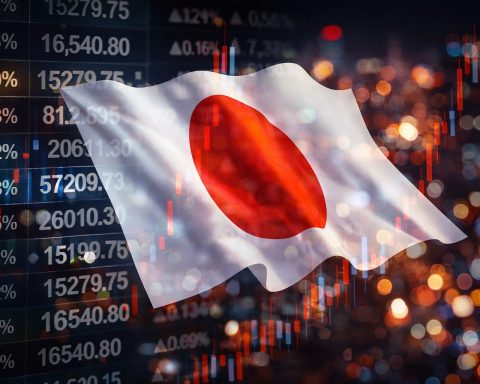TOKYO — Japan’s stock market pushed higher on Thursday as a weaker yen, the end of the record U.S. government shutdown and solid demand for value and financial shares helped extend this week’s rally on the Tokyo Stock Exchange.
Key takeaways
- Nikkei 225 climbed 0.43% to 51,281.83, its fifth gain in six sessions.
- Topix jumped 0.67% to a record 3,381.72, led by banks, utilities and brokers. [1]
- Yen hovered near ¥155 per dollar after fresh producer‑price data and continued political pressure to keep interest rates low, supporting exporters but intensifying debate over possible intervention. [2]
Nikkei edges up, Topix sets fresh record
The benchmark Nikkei 225 index added 218.52 points, or 0.43%, to close at 51,281.83, consolidating above the psychologically important 51,000 line. [3]
The broader Topix index outperformed, gaining 22.39 points (0.67%) to finish at 3,381.72, its highest close on record and the fourth straight day of advances. [4]
Market breadth underlined the positive tone. On the TSE Prime market, 952 stocks advanced, 604 declined and 56 were unchanged, according to data cited by Xinhua, suggesting the rally extended across sectors rather than being driven by a handful of heavyweights. [5]
A separate tally from Investing.com showed rising shares outnumbering fallers on the wider Tokyo Stock Exchange by roughly 2,000 to 1,600, with about 200 issues flat. [6]
End of U.S. shutdown and global risk mood support Tokyo
The gains in Tokyo came as investors around the world digested the reopening of the U.S. federal government after a 43‑day shutdown, the longest on record. U.S. President Donald Trump signed legislation late Wednesday to restore funding, allowing agencies to resume operations and clearing the way for delayed economic data to be released. [7]
In the days leading up to the deal, global equities had already rallied on hopes that Washington would reach an agreement. The Dow Jones Industrial Average closed at a record high earlier in the week, even as tech‑heavy benchmarks like the Nasdaq showed signs of fatigue amid profit‑taking in artificial‑intelligence names. [8]
That rotation away from pricey U.S. growth stocks spilled over into Asia. Commentators noted that Japanese investors are increasingly shifting portfolios from high‑valuation AI plays into financials, utilities and other value sectors, mirroring trends on Wall Street. [9]
Weaker yen boosts exporters and value shares
Another powerful tailwind for Japan stocks on Thursday was the continued weakness of the yen.
- The U.S. dollar traded around ¥154.4–155.0, slipping slightly on the day but still close to Wednesday’s nine‑month high of ¥155.05 against the Japanese currency. [10]
- The yen has also fallen to historic lows against the euro, prompting fresh verbal warnings from Japan’s finance ministry. [11]
A Reuters analysis published Thursday described how global investors who had bet on a yen rebound earlier this year have been wrong‑footed, as robust U.S. growth and a slower‑than‑expected pace of Federal Reserve rate cuts kept the interest‑rate gap wide in favor of the dollar. [12]
Meanwhile, new Prime Minister Sanae Takaichi has repeatedly signaled a preference for keeping interest rates low to support domestic demand, a stance markets see as limiting how far the Bank of Japan (BOJ) can tighten policy despite inflation running above its 2% target at times. [13]
Against that backdrop, a cheap yen continues to be good news for exporters:
- Xinhua reported that the currency’s slide into the upper ¥155-per-dollar range helped lift auto stocks such as Toyota Motor, which benefit when overseas earnings are translated back into yen. [14]
The weaker currency also keeps Japan attractive for global investors seeking carry trades, where they borrow in low‑yielding yen to invest in higher‑yielding assets elsewhere—fuel for ongoing interest in Japanese equities. [15]
Sector snapshot: Tech, utilities and banks lead; SoftBank weighs
Thursday’s advance in Tokyo was broad‑based but uneven across industries.
Tech and electronics
Semiconductor‑related names were again in focus:
- Advantest, which makes testing equipment for chips, climbed about 4.2%, making it the single biggest positive contributor to the Nikkei’s gain, according to Reuters data carried by multiple outlets. [16]
- Fibre‑optic and electrical cable makers rallied strongly, with Fujikura up roughly 3.2%, Furukawa Electric surging about 12.2% and Sumitomo Electric adding around 7% as investors snapped up undervalued cyclicals linked to infrastructure and data demand. [17]
On the broader Nikkei 225:
- Medical‑information platform M3 Inc. jumped 23.5%, hitting a 52‑week high.
- Isuzu Motors rose nearly 12%, touching a five‑year peak. [18]
Financials and utilities
The financial sector provided steady support:
- Mitsubishi UFJ Financial Group gained around 2%, while Sumitomo Mitsui Financial Group and Mizuho Financial Group rose about 1.2% and 2.6%, respectively, helped by expectations that a steeper global yield curve will bolster bank profitability. [19]
- Reuters also noted that the utilities sub‑index jumped just over 3%, and brokerage stocks added about 2%, underscoring bullishness on defensive and fee‑driven names as domestic retail trading activity remains healthy. [20]
Investing.com similarly reported that real estate, banking and textile shares were the strongest performers among Nikkei sectors, reinforcing the sense that Thursday’s move was more about value and domestic demand than high‑beta growth. [21]
Laggards: healthcare, chemicals and SoftBank
Not all heavyweights participated:
- Medical‑device maker Terumo slid more than 6%, while chemical group Kuraray dropped nearly 6%. [22]
- Technology conglomerate SoftBank Group fell around 3.4%, making it the biggest drag on the Nikkei as investors continued to reassess lofty valuations tied to private tech holdings and AI exposure. [23]
Domestic inflation data: Producer prices confirm gradual pickup
Adding to the macro backdrop, the Bank of Japan released its latest Corporate Goods Price Index (CGPI) figures for October on Thursday morning.
Key points from the BOJ report:
- Producer Price Index (PPI) rose 0.4% month‑on‑month, up from 0.3% in September and marking the second consecutive monthly increase. [24]
- On a year‑on‑year basis, producer prices were 2.7% higher, while the overall index reached about 127.5 (2020=100), an all‑time high, according to data compiled by Trading Economics and other trackers. [25]
- Export prices in contract‑currency terms rose 1.0% and import prices 0.7% from the previous month, reflecting both higher commodity prices and the weaker yen. [26]
The numbers confirm that upstream price pressures remain moderate but persistent, supporting the BOJ’s cautious stance: inflation is no longer near zero, yet policymakers have argued that underlying price growth is still “somewhat below” the 2% target on a sustainable basis. [27]
For equities, modest PPI firming is a mixed signal: it can improve pricing power for manufacturers and exporters, but it also feeds the debate over how long ultra‑low interest rates can be maintained without risking further yen weakness.
Earnings watch: Inpex, Nitori and other corporate stories
Thursday also brought a batch of earnings updates from major Japanese companies, adding stock‑specific catalysts to the macro‑driven rally.
Inpex: Profit up despite lower revenue
Energy producer Inpex Corp. reported results for the nine months to September 30:
- Revenue fell about 13% year‑on‑year to roughly ¥1.52 trillion amid lower oil prices and currency effects.
- Operating profit declined 14%, but profit attributable to owners of the parent edged up about 1.4% to ¥293.4 billion, supported by cost controls and lower income‑tax expenses. [28]
The company also raised its full‑year profit forecast by ¥20 billion to around ¥390 billion, citing stable operations and optimized costs. [29]
While Inpex is not a Nikkei heavyweight on the scale of Toyota or SoftBank, its update is a key barometer for Japan’s resource sector and for how domestic firms are weathering volatile commodity and FX markets.
Nitori: Furniture giant’s profits soften but outlook steady
Home‑furnishing retailer Nitori Holdings released results for the first half of its FY2025 year (April–September):
- Revenue slipped to about ¥439.1 billion, roughly 98% of the level a year earlier, as consumers grappled with cost‑of‑living pressures.
- Operating profit and net income also declined, prompting headlines that “H1 earnings fell,” but the company reiterated its full‑year FY2026 outlook, signaling confidence in demand and overseas expansion. [30]
Nitori also highlighted healthy free‑cash‑flow generation and continued store openings both in Japan and across Asia, suggesting it plans to lean into its long‑term growth strategy despite short‑term margin pressure. [31]
Market structure and regulation: TSE, crypto stocks and upcoming relistings
Beyond index moves and earnings, market structure news also drew attention in Tokyo on November 13.
JPX and “crypto‑treasury” companies
Several crypto‑industry outlets reported that Japan Exchange Group (JPX), which operates the Tokyo Stock Exchange, is considering tighter scrutiny of listed companies that transform themselves into “digital‑asset treasury” firms—businesses that primarily hold Bitcoin or other crypto assets on their balance sheets. [32]
According to these reports, potential steps under discussion include:
- tougher audits for companies shifting their core business toward large crypto holdings;
- stricter checks on backdoor listings where dormant firms pivot into digital‑asset plays;
- broader disclosure requirements for volatility and risk management.
However, JPX moved quickly to cool speculation. In an official “Media Report” note published Thursday, the TSE said that while a media outlet had claimed it was “considering strengthening regulations on crypto asset treasury companies,” “no specific policy has been decided” at this point. [33]
The debate has been stoked in part by headline‑grabbing moves from firms such as Metaplanet, whose aggressive accumulation of Bitcoin has driven a roughly 1,700% year‑on‑year surge in reported revenue and sharp swings in its share price. [34]
For investors, the episode underscores that regulatory risk is rising for Japan’s small‑cap crypto‑themed stocks, even as JPX stresses that formal rule changes are still under consideration rather than imminent.
SBI Shinsei Bank approved for relisting
Separately, the Tokyo Stock Exchange approved the relisting of SBI Shinsei Bank on its top‑tier Prime section, with trading scheduled to start on December 17. [35]
- The bank’s initial public offering price is expected to be ¥1,440 per share, implying a market capitalization of about ¥1.3 trillion.
- SBI Shinsei is the latest chapter in the long saga of the former Long‑Term Credit Bank of Japan, which failed in 1998, was nationalized, revived as Shinsei Bank, and later became a subsidiary of SBI Holdings before being delisted in 2023. [36]
The upcoming relisting highlights how Japan’s financial sector continues to restructure more than two decades after its banking crisis, and it will add another sizable lender to the Prime market that already buoyed Topix on Thursday.
What today’s move means for investors
Thursday’s action in the Japan stock market sends a few clear signals:
- Rotation into value is real. Strong gains in banks, utilities, brokers and industrials—and fresh records for Topix—suggest investors are broadening beyond the AI and megacap tech names that led earlier phases of the rally. [37]
- Yen weakness is still the market’s friend, but a political headache. A currency near ¥155 per dollar boosts exporters and foreign earnings, yet it is also provoking louder debate about BOJ policy, the risk of FX intervention and the longer‑term health of domestic consumption. [38]
- Inflation is edging up, not exploding. Producer prices are rising at a manageable pace, giving the BOJ some room to keep rates low while monitoring second‑round effects. That balance is crucial for equity valuations and for sustaining carry‑trade inflows. [39]
- Regulatory and governance themes are back in focus. From crypto‑heavy small caps to the relisting of SBI Shinsei Bank, Tokyo is reminding investors that market structure and corporate governance reforms are an ongoing part of the Japan story. [40]
For now, Japan’s stock market on November 13, 2025 stands out as a relative bright spot: a major developed market hitting new highs on its broader index, supported by global risk appetite, a competitive currency and incremental domestic inflation rather than runaway price pressures.
How sustainable that mix proves to be will depend on three watchpoints in the coming weeks:
- renewed U.S. economic data after the shutdown and what they imply for Fed policy; [41]
- any shift in tone from the Bank of Japan or the government as the yen hovers near multi‑year lows; [42]
- and whether earnings from exporters, retailers and financials confirm that corporate Japan can keep delivering profit growth into 2026.
For investors tracking “Japan stock market today”, Thursday’s session offered a clear message: the bull case is increasingly about breadth, value and policy support—not just about a weak currency or a handful of tech champions.
References
1. www.indopremier.com, 2. www.reuters.com, 3. indexes.nikkei.co.jp, 4. www.indopremier.com, 5. english.news.cn, 6. m.investing.com, 7. www.reuters.com, 8. www.reuters.com, 9. www.share-talk.com, 10. www.reuters.com, 11. www.reuters.com, 12. www.reuters.com, 13. www.reuters.com, 14. english.news.cn, 15. www.reuters.com, 16. www.indopremier.com, 17. www.indopremier.com, 18. m.investing.com, 19. www.indopremier.com, 20. www.indopremier.com, 21. m.investing.com, 22. m.investing.com, 23. www.indopremier.com, 24. www.boj.or.jp, 25. www.boj.or.jp, 26. www.boj.or.jp, 27. www.reuters.com, 28. www.rttnews.com, 29. www.inpex.com, 30. www.nitorihd.co.jp, 31. www.nitorihd.co.jp, 32. www.coinspeaker.com, 33. www.jpx.co.jp, 34. www.coinspeaker.com, 35. www.nippon.com, 36. www.nippon.com, 37. www.indopremier.com, 38. www.reuters.com, 39. www.boj.or.jp, 40. www.nippon.com, 41. www.reuters.com, 42. www.reuters.com










